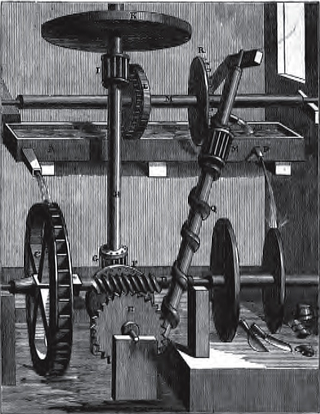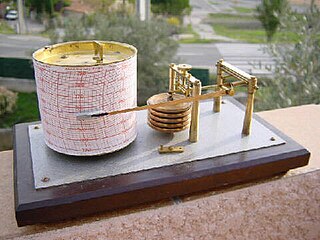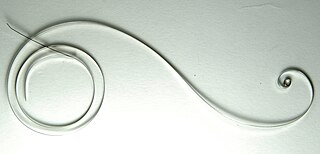
Pressure measurement is the measurement of an applied force by a fluid on a surface. Pressure is typically measured in units of force per unit of surface area. Many techniques have been developed for the measurement of pressure and vacuum. Instruments used to measure and display pressure mechanically are called pressure gauges,vacuum gauges or compound gauges. The widely used Bourdon gauge is a mechanical device, which both measures and indicates and is probably the best known type of gauge.

A barometer is a scientific instrument that is used to measure air pressure in a certain environment. Pressure tendency can forecast short term changes in the weather. Many measurements of air pressure are used within surface weather analysis to help find surface troughs, pressure systems and frontal boundaries.

Perpetual motion is the motion of bodies that continues forever in an unperturbed system. A perpetual motion machine is a hypothetical machine that can do work infinitely without an external energy source. This kind of machine is impossible, since its existence would violate the first and/or second laws of thermodynamics.

Clockwork refers to the inner workings of either mechanical devices called clocks and watches or other mechanisms that work similarly, using a series of gears driven by a spring or weight.

The history of perpetual motion machines dates at least back to the Middle Ages. For millennia, it was not clear whether perpetual motion devices were possible or not, but modern theories of thermodynamics have shown that they are impossible. Despite this, many attempts have been made to construct such machines, continuing into modern times. Modern designers and proponents sometimes use other terms, such as "overunity", to describe their inventions.

A barograph is a barometer that records the barometric pressure over time in graphical form. This instrument is also used to make a continuous recording of atmospheric pressure. The pressure-sensitive element, a partially evacuated metal cylinder, is linked to a pen arm in such a way that the vertical displacement of the pen is proportional to the changes in the atmospheric pressure.

Cornelis Jacobszoon Drebbel was a Dutch engineer and inventor. He was the builder of the first operational submarine in 1620 and an innovator who contributed to the development of measurement and control systems, optics and chemistry.

A mainspring is a spiral torsion spring of metal ribbon—commonly spring steel—used as a power source in mechanical watches, some clocks, and other clockwork mechanisms. Winding the timepiece, by turning a knob or key, stores energy in the mainspring by twisting the spiral tighter. The force of the mainspring then turns the clock's wheels as it unwinds, until the next winding is needed. The adjectives wind-up and spring-powered refer to mechanisms powered by mainsprings, which also include kitchen timers, metronomes, music boxes, wind-up toys and clockwork radios.

The vergeescapement is the earliest known type of mechanical escapement, the mechanism in a mechanical clock that controls its rate by allowing the gear train to advance at regular intervals or 'ticks'. Verge escapements were used from the late 13th century until the mid 19th century in clocks and pocketwatches. The name verge comes from the Latin virga, meaning stick or rod.

Philip Deidesheimer was a mining engineer in the Western United States.

Atmos is the brand name of a mechanical torsion pendulum clock manufactured by Jaeger-LeCoultre in Switzerland which does not need to be wound manually. It gets the energy it needs to run from temperature and atmospheric pressure changes in the environment, and can run for years without human intervention.

Nathan Read was an American engineer and steam pioneer.
Peter A. Griffin was a mathematician, author, and blackjack expert and is one of the original seven members of the Blackjack Hall of Fame. He authored The Theory of Blackjack, considered a classic analysis of the mathematics behind the game of casino 21.

John Joseph Merlin was a Belgian Freemason, clock-maker, musical-instrument maker, and inventor from the Prince-Bishopric of Liège in the Holy Roman Empire. He moved to England in 1760. By 1766 he was working with James Cox and creating automatons such as Cox's timepiece and the Silver Swan. By 1773 he was designing and making innovative keyboard instruments. In 1783 he opened Merlin's Mechanical Museum in Princes Street, Hanover Square, London, a meeting-place for the gentry and nobility. In addition to his clocks, musical instruments and automata, Merlin is credited with the invention of inline skates in the 1760s. He was referred to by contemporaries as "The Ingenious Mechanic". He was friendly with composer Joseph Haydn.
The Barker lever is a pneumatic system which multiplies the force of a finger on the key of a tracker pipe organ. It employs the wind pressure of the organ to inflate small bellows called "pneumatics" to overcome the resistance of the pallets (valves) in the organ's wind-chest. This lever allowed for the development of larger, more powerful organs still responsive to the human hand. These larger organs first flourished in France, e.g., the organ produced by Cavaillé-Coll at St. Sulpice. The first Barker lever was built in the Cavaillé-Coll organ of the Basilica of Saint-Denis.

James Cox was a British jeweller, goldsmith and entrepreneur and the proprietor of Cox's Museum. He is now best known for creating ingenious automata and mechanical clocks, including Cox's timepiece, powered by atmospheric pressure, the Peacock Clock and the Silver Swan.

John Henry Lienhard IV is Professor Emeritus of mechanical engineering and history at The University of Houston. He worked in heat transfer and thermodynamics for many years prior to creating the radio program The Engines of Our Ingenuity. Lienhard is a member of the US National Academy of Engineering.

Mathematical Magick is a treatise by the English clergyman, natural philosopher, polymath and author John Wilkins. It was first published in 1648 in London, another edition was printed in 1680 and further editions were published in 1691 and 1707.
Ahasuerus Fromanteel was a clockmaker, the first maker of pendulum clocks in Britain.
Comitti of London is a British company which designs and manufactures handcrafted timepieces.
















